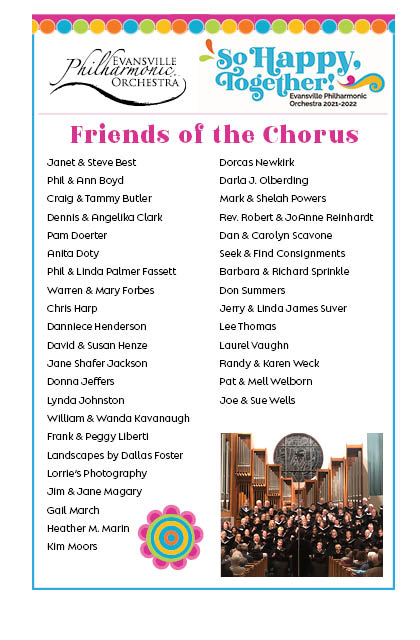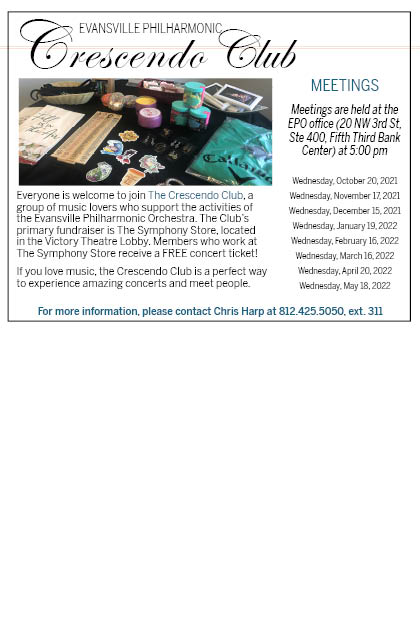
Opening Night
American Visionaries
SATURDAY, SEPTEMBER 25, 2021 AT 7:00 P.M.
VICTORY THEATRE
Roger Kalia, Conductor • Fei-Fei, Piano
Erin Lewis & Ruben Recinos, Dancers
CONCERT SPONSOR
PROGRAM
Fei-Fei, Piano
Nimble Feet
Tropical Noon
Silk Hat and Walking Cane
Prologue (Allegro Moderato)
‘Somewhere’ (Adagio)
Scherzo (Vivace e Leggiero)
Mambo (Meno Presto)
Cha-Cha (Andantino Con Grazia)
Meeting Scene (Meno Mosso)
‘Cool’, Fugue (Allegretto)
Rumble (Molto Allegro)
Finale (Adagio)
Official IT Services Provider
Steinway is the official piano of the Evansville Philharmonic Orchestra.

PROGRAM NOTES
Written by Bill Hemminger
“River City Re-Awakened”
“River City Re-Awakened” is composer Paul Dooley’s tribute to the vitality of riverine Evansville and to his friend and colleague Roger Kalia, conductor of the Evansville Philharmonic Orchestra. The long list of accomplishments of Paul Dooley (born 1983) belies his young age: works of his have been commissioned by professional organizations from Nashville Symphony to the United States Navy Band, and his many compositions—which take inspiration from dance, nature, and travel—may be heard on numerous recordings. Among his teachers was Frank Ticheli (see “Special Surprise”), and Dooley now teaches at University of Michigan.
In his own description of his 2021 composition, Dooley describes the “playful and heartwarming” melodies of the work as his gift to the EPO, to the city of Evansville, and to Kalia’s “spirited conducting.” Dooley’s work intentionally highlights the fine abilities of EPO instrumentalists, and various sections of the orchestra are featured in extended solos. The work concludes with a grand waltz led by the brass section, which may well serve to “re-awaken” the river city.
“Rhapsody in Blue”
George Gershwin (1898-1937) was certainly one of the great American musical visionaries. The young New Yorker who left school at the age of 15 to work as a song-plugger on Tin Pan Alley became the world-renowned composer of “Porgy and Bess,” “Fascinating Rhythm,” “An American in Paris,” and “Rhapsody in Blue.” And all of this was accomplished before his untimely death at 38.
In the 1920s famous bandleader Paul Whiteman had asked Gershwin to write a “jazz concerto” that Whiteman might feature at one of his popular concerts. Early in 1924, Gershwin was reminded of his promise—except that the premiere of the work was slated for February 12 that year! Gershwin set to work immediately and began writing while taking the train from New York to Boston, where one of his musicals was opening. Almost all accounts of that trip indicate that it was the regular clanging noises of the train that stimulated the composer to create, in Gershwin’s words, “a musical kaleidoscope of America—of our vast melting pot, of our unduplicated national pep, of our metropolitan madness.” Gershwin returned to New York with scarcely more than a sketch of the work, handed his incomplete score to Ferde Grofé, Whiteman’s orchestrator (and accomplished composer in his own right), and played the concert to tremendous acclaim. At the time of the concert, there was no written-out piano part; Gershwin played from memory. In 1926 Grofé redid the orchestration to accommodate a modern, larger symphony orchestra; and it is this version that you will hear tonight.
Early in the composition process, Gershwin knew that he wanted to call his work a “rhapsody,” which would better fit the free-form composition he envisioned as opposed to a more conventional concerto, jazzy or not. It was Gershwin’s brother Ira who added “in blue,” after attending an art exhibition featuring the works of James Abbot McNeill Whistler (of “Whistler’s Mother” fame). Whistler provided abstract titles—“Arrangement in Grey and Black” or “Nocturne: Blue and Gold,” for instance) for many of his works, and Gershwin took to the name of the color that also suggested a musical genre. The much-heralded concerto had become a rhapsody, and its jazz connection had morphed into blues.
“Dances in the Canebrakes”
Florence Beatrice Smith Price (1887-1953) was the first Black woman to earn national recognition in composition and performance (piano and organ) of classical music. She graduated with an artist’s diploma from the New England Conservatory of Music in 1906, returned to her native Arkansas to teach, ultimately moving to Chicago where she worked as a concert pianist, organist, and composer.
“Dances in the Canebrakes” was originally written as a suite for piano and was completed just months before Price’s death. “Cane” or “canebrakes” refers to bamboo-like grasses that flourish in the subtropical wetlands of the American South. By definition the canebrake grew where crops could not, and tangles of cane stretched along rivers and streams. Slaves were sent to clean out the canebrakes, which was likely a time for singing and dancing (in addition to back-breaking work). Price’s suite is divided into three sections; all are rags, dances built on jaunty, syncopated (”ragged”) rhythms and charming tunes. Price gave names to the three movements of her work: “Nimble Feet,” “Tropical Noon,” and “Silk Hat and Walking Cane.”
It was yet another Black composer in the classical tradition, William Grant Still (1895-1978), who orchestrated Price’s piano suite. Like Price, Still grew up in Arkansas and defied prejudices of the time in order to complete serious training in classical music and then embark on a long and very successful musical career. Still wrote operas and symphonies, arranged music for films, conducted major orchestras; he was also an important figure in the Harlem Renaissance of the 1920s and 30s.
Symphonic Dances from “West Side Story”
What program of visionary concert music from American composers could be complete without a work of Leonard Bernstein (1918-1990)? Like Gershwin, Bernstein came from a Ukrainian-Jewish family and was similarly precocious. While a music student at Harvard, Bernstein noted that his only “real” composition instructor was Aaron Copland. After post-graduate study at Curtis Institute, Bernstein moved to New York, where he took jobs conducting, arranging, and transcribing music. In the 1950s he launched himself into writing musicals, more like symphonic operas than typical light Broadway fare. Soon, in 1956, Candide premiered; later, in 1957, West Side Story was born, having cast off its original East Side Story roots. Part of the impetus to change both the location and the ethnic make-up of the musical (Irish and Jewish characters had populated the east side story) had to do with the fact that, at the time of the creation of the musical, much of the lower East Side of New York was being demolished to make way for, among other things, Lincoln Center. Certainly the music of West Side Story—which appears nowadays in TV commercials, on half-time high school band shows, and tonight on this program—is among the most recognizable and beloved music from any time. Still today West Side Story stands as a major chapter in American theatre.
West Side Story hit the silver screen in 1961 where it became a major box office success. The same year, Bernstein assembled nine sections of the musical into an orchestra-ready suite of Symphonic Dances. In Bernstein’s own language, here are the nine sections:
- Prologue: “The growing rivalry between two teenage gangs, the Jets and the Sharks.”
- “Somewhere”: “In a visionary dance sequence, the two gangs are united in friendship.”
- Scherzo: “In the same dream, they break through the city walls, and suddenly find themselves in a world of space, air and sun.”
- Mambo: “Reality again, competitive dance between the gangs.”
- Cha-Cha: “The star-crossed lovers see each other for the first time and dance together.”
- Meeting Scene: “Music accompanies their first spoken words.”
- “Cool” Fugue: “An elaborate dance sequence in which the Jets practice controlling their hostility.”
- Rumble: “Climactic gang battle during which the two gang leaders are killed.”
- Finale: “Love music developing in to a processional, which recalls, in tragic reality, the vision of ‘Somewhere’.”
"Special Surprise”
This surprise addition to the concert program is truly special. It is an elegiac a cappella choral work by well-known American composer Frank Ticheli, who was born in 1958. A prolific composer in almost all musical genres, Ticheli has taught music composition at University of Southern California since 1991 and has garnered innumerable awards and commissions.
The song’s text, “There Will Be Rest,” is a poem by American poet Sara Teasdale, 1884-1933. In many ways, Teasdale’s poem acts as an appropriate honor to people who have died from Covid-19 and to the healthcare workers that have cared for all of us. Teasdale, who had had bouts of depression throughout her life, took her own life a month after the poem was written. In the poem, the poet appears to take comfort in the knowledge that a final rest will come with “sure stars shining” and “serene forgetting.” In death the speaker will find “the crystal of peace” in the unwavering reality of the constant stars. Ticheli’s setting of the poem gives plaintive voice to this yearning for peace—even when that peace comes at the cost of human life, but under the spangle of stars.
|
There will be rest, and sure stars shining I will make this world of my devising |
- Podcast
- Conductor Biographies
- Bill Hemminger Biography
- Photos
- Videos
- Articles and Reviews
- Radio Broadcast Schedule
- History of the EPO
- Mission and Values
- Board of Directors 2025-2026
- Sponsors 2025-2026
- Philharmonic Gives Back
- Donors 10/1/2024 - 10/1/2025
- Thoughtful Tributes 10/1/2024 - 10/1/2025
- Past Events






















